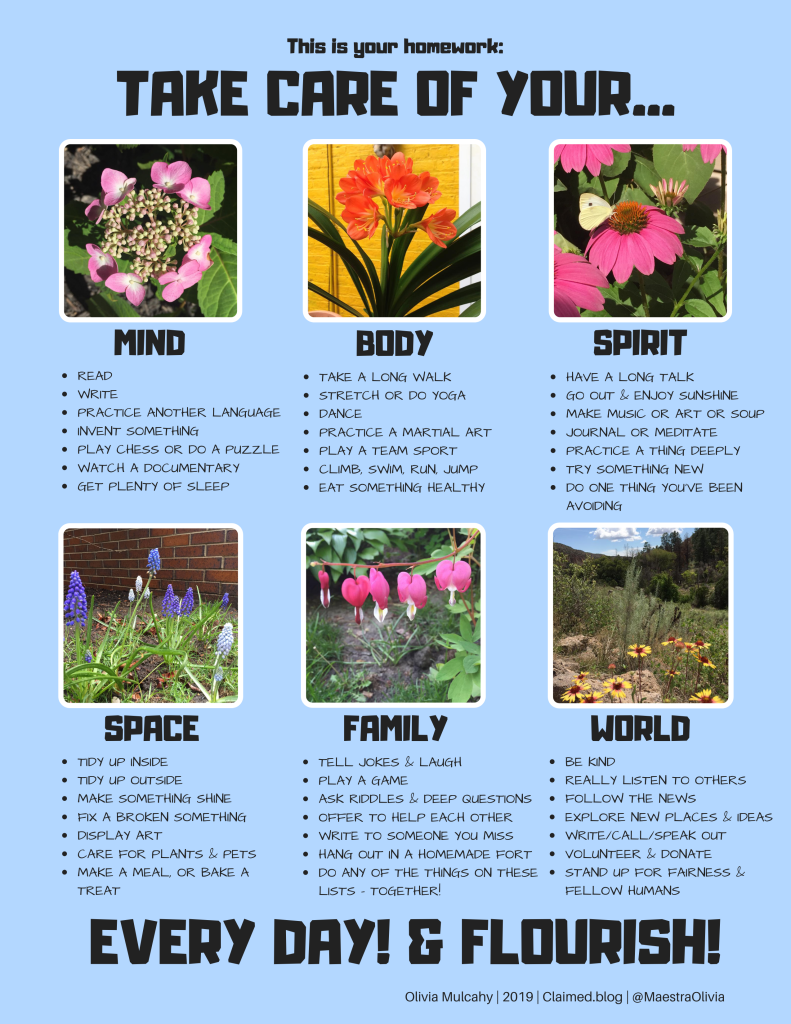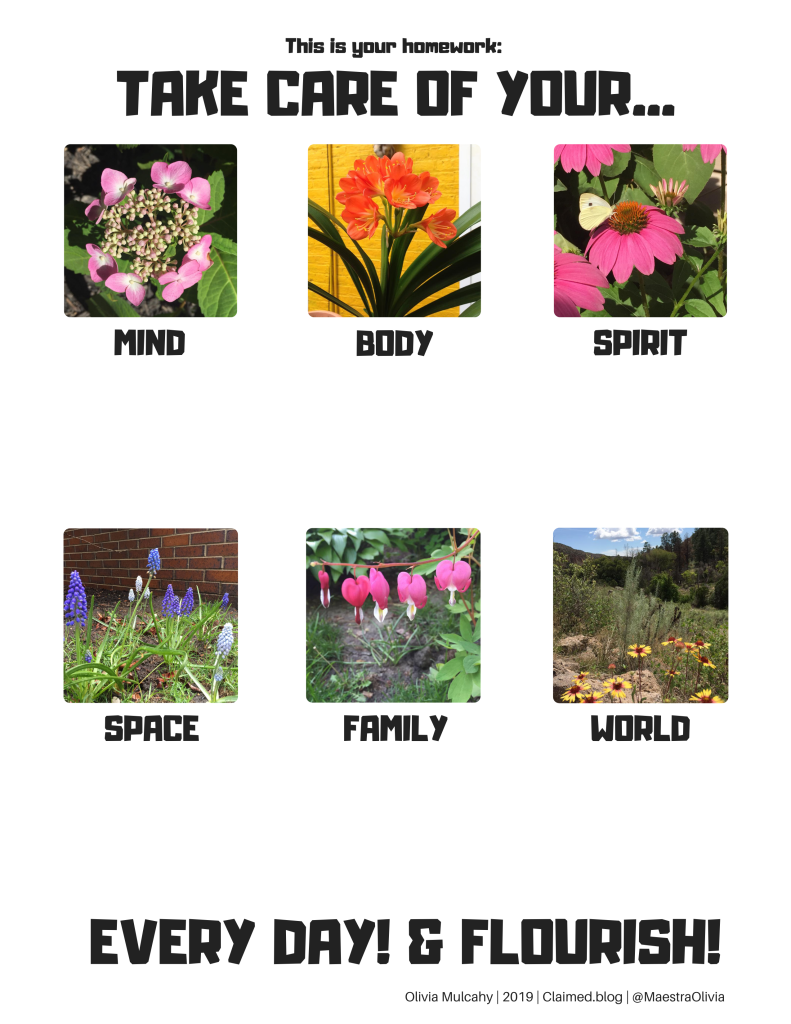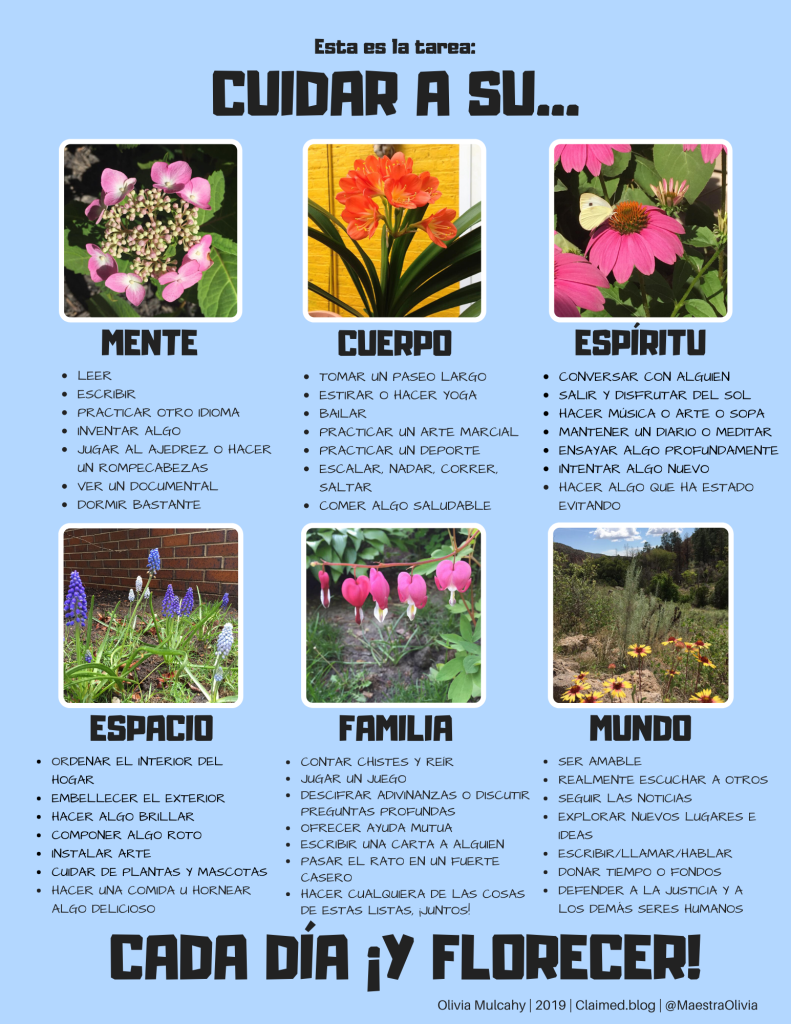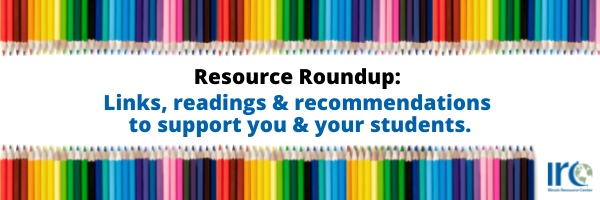by Olivia Mulcahy
This blog entry was originally published by Olivia Mulcahy on her blog, claimed.blog.
A while ago I wrote about how we might reimagine homework as the task of taking care. Now, as so many people are hunkering down to do all their living and schooling and working at home, I’m thinking we need to take this idea to another level entirely. It’s an idea I think might help any of us get through the crises catalyzed and exacerbated by the Coronavirus, but right now I’m specifically thinking about how it might help guide schools as they manage an enormous and abrupt shift in how and what they do. As educators scramble to figure out how to facilitate remote learning amid a global pandemic, I’m thinking we need to take this moment to approach the entire endeavor as one big communal effort to take care.
Take care. That’s it. That’s the curriculum.
This. is. a. pandemic. So first and foremost schools should be attending to the well being of the people in their communities. We should basically all be on an extended spring break (not in a tropical vacation kind of way, but as in, please pause all assignments) and using this time to make arrangements for our own wellness, opening channels of communication, and establishing mutual aid networks. THEN, we can start thinking about integrating instruction as thoughtfully, responsively, and authentically as we can.
We might consider, what lessons are most pertinent in the middle of a pandemic? I think it seems like a great time to think on some of those offered to us by Grace Lee Boggs, starting with, “the only way to survive is to take care of each other.” Feels like a perfect moment to explore the concept of ubuntu (I am because you are) or the idea of in lak’ech (Tú eres mi otro yo). Myself, I have been finding it timely to dig into conversations about indigenous perspectives on community and stewardship with my own kids as they take turns reading our copy of An Indigenous Peoples’ History of the United States for Young People.
That is all to say that, during this pandemic, I hope we give ourselves the space and the grace to simply take care of ourselves and I hope that we realize that our own ability to survive and thrive is bound up with everyone else’s. We must understand that self-care and care for family, community, and our world are each important and also inextricable from each other. Of course, this has always been true. But it is a lesson that clearly many have not yet learned well enough.
As we think about what additional kinds of lessons might be worthy of our students’ energy during this unique Right Now, we must also keep in mind that everyone is experiencing this moment differently. Some are wrestling with solitude, or separation from loved ones, or struggling with an uncomfortable new degree of familial togetherness. Some are grateful for a little space to themselves or enjoying quality time with their co-quarantining companions. Some are managing physical illness, worry, fear, grief, anxiety, depression. Some are finding relief at having more creative time, time outside, time to relax, time with family. Some are busy and overwhelmed with new responsibilities, while others are bored and restless. Some are craving their familiar routines while others are glad to be free of them. Some are missing their teachers or missing meals. Some don’t have a home to hunker down in or have a home that is not a safe place. For some this pandemic has caused new challenges, and for others it has made existing challenges even more acute.
The variability is endless. THAT is the only thing we can count on as a constant. (Of course, this has always been true. The range of variability among our students is huge even when we are not living in plague times. Yet designing curriculum in a way that anticipates and addresses difference is a practice that many have not yet taken up well enough.)
So how do we design learning opportunities that account for all this variability and are remotely equitable? (See what I did there? Sorry.)
I believe that taking care is the key. I went back to look at the design principles from my original “Take Care” chart: worthy, collective, possible, co-constructed, flexible and fluid, hefty but not heavy. I feel like these can serve a purpose, not just as a framework for homework as I originally thought, but perhaps for the whole curriculum, especially now that all schoolwork IS homework.
Pandemic Era Remote Learning that everyone can access might look like this:
- Teachers use the Take Care chart to brainstorm with students and families lots of possible and engaging options in each category, including options that can be collectively undertaken. (Please note: Not all kids have access to tech, so in the chart with my examples there is no tech necessary, though one can imagine where e-learning options and such could have a role.)
- Teachers propose a flexible system and reasonable timeline for using the chart, working with students to co-construct goals that reflect a (maybe hefty, but definitely) not heavy balance of worthy activities across the categories.
- Teachers offer students ways to document their experiences and reflect on what they are learning from them. (I’m thinking, some sort of calendar, notebook, or portfolio)
- Teachers and students communicate however and as regularly as possible to check in about how everyone is taking care. Students have a chance to share any work or questions, teachers can offer guidance and feedback.
- Teachers approach any assessment as supportive and formative and engage in nothing that is final, high-stakes or anxiety-producing. (Some kids are just surviving and have no bandwidth for our assignments. We don’t always know who they are. It would be unfair, unethical, and cruel to penalize anyone with bad grades right now. )
- Teachers plan fluidly based on how things evolve, and focus on sustaining students’ and their own momentum on the work of taking care.
This may sound simple. I hope it does, because nobody has time for complicated planning right now. And, though the plan may be simple, I believe we can use it as an all ages, cross-disciplinary, inclusive, compassionate framework to guide truly authentic, complex, and potent meaning making for all of us during this extremely difficult time.
What we CANNOT do is create an alternate COVID-19 remote learning universe that replicates what we have been doing. (No shade towards any of my wonderful teacher colleagues out there! My issue here is with the systems, not individuals.) We must not shape our crisis education efforts to conform to the same problematic models of schooling, and we MUST NOT maintain the hope of returning to normal. The “old” normal was NOT good enough. In our “old” normal, inequity is SO normalized that we dragged our feet on closing schools, knowing that would slow the virus but also knowing how many families rely on schools for basic survival things like food, shelter, and childcare. We live in a society where we we allow people to suffer food, housing, economic, and health insecurity as a norm–where it is normal not to take of each other.
So, as I see it, this is a moment to try out what I hope is our next new normal. This is the moment…
- To make real space to connect and deepen relationships with students and their families.
- To trust in families’ funds of knowledge and affirm the experiences, skills, wisdom, cultural perspectives and language practices in their homes as valued sources of learning.
- To truly attend to all the dimensions of student variability using Universal Design for Learning as a framework for equity.
- To enact culturally and linguistically responsive pedagogies that center and affirm our students’ cultures, languages, identities, and lived experiences.
- To get serious about thoroughly integrating social emotional learning and practicing trauma-informed education.
- To embrace arts integration as a way to make learning more accessible, differentiated, personally meaningful, enriching, and joyful.
- To invite and support everyone in exploring multiple perspectives and becoming more multilingual.
- To encourage inquiry and project based learning, starting with students’ genuine questions and true passions.
- To get creative with interdisciplinary investigations and thematic exploration across content areas.
- To realize the power of reflective learning and student self-assessment over rigid grading practices and standardized tests.
- To empower our students as collaborators and innovators through problem based learning (so many real problems to choose from!) and design thinking challenges.
- To examine the bias, racism, ableism, sexism, cisheteronormativity, economic and ecological violence that have shaped our systems and plagued our schools for far longer than the Coronavirus.
- To take up the critical conversations and professional learning that will help us build competence, grow confidence, and take action as a community of educators doing this work.
I imagine you looking at this list, dear reader, and fear it may feel daunting to you. If so, I urge you to breathe and consider it again, because I look at it and think:
1) These things may actually be MORE feasible to enact during this pandemic shelter-in-place situation than trying to recreate a conventional classroom experience remotely,
2) These are the practices that are often sidelined, paid lip service, under-valued, compartmentalized, perceived as extra…but SHOULD be centered, prioritized, integrated, and normal because,
3) They reflect a rich, empowering education that would DO BETTER by each and all of our students,
4) They represent deep and difficult BUT much more joyful and nourishing work for teachers than scripted curricula and purchased programs. And BY THE WAY, if we were already doing all this,
5) Our students and teachers would be much better prepared to handle this whole remote learning in a crisis thing.
Whew.
OK. That’s it. Take Care. Be well. Much love.
Oh, and here are sample and blank Take Care charts in English and in Spanish if you like…







